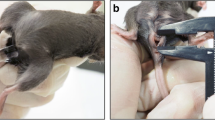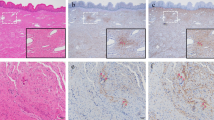Abstract
Introduction and hypothesis
We investigated whether the expression of alpha-1 antitrypsin (ATT), neutrophil elastase (NE), and lysyl oxidase-like protein 1 (LOXL-1) vary within the vagina in subjects with pelvic organ prolapse (POP).
Methods
Biopsies were obtained from the anterior and posterior vaginal wall of 22 women with POP (≥stage 2 by POP-Q). The subjects were grouped by the most prominent defect: cystocele, cystocele plus uterine prolapse, and rectocele. Comparative real-time PCR, Western blotting, and NE enzyme activity assay were performed.
Results
The ratio of anterior and posterior vaginal wall ATT, NE, and LOXL-1 expression varied between individuals within the same defect group.
Conclusions
ATT, NE, and LOXl-1 expression was variable among different biopsy sites in the vagina. No consistent pattern was present when the subjects were grouped by the most prominent defect. We recommend careful consideration of biopsy sites in future studies on POP to enhance reproducibility of data.


Similar content being viewed by others
References
Chen B, Wen Y, Yu X, Polan ML (2005) Elastin metabolism in pelvic tissues: is it modulated by reproductive hormones? Am J Obstet Gynecol 192:1605–1613
Nygaard I, Bradley C, Brandt D (2004) Pelvic organ prolapse in older women: prevalence and risk factors. Obstet Gynecol 104:489–497
Samuelsson EC, Victor FT, Tibblin G, Svardsudd KF (1999) Signs of genital prolapse in a Swedish population of women 20 to 59 years of age and possible related factors. Am J Obstet Gynecol 180:299–305
Swift SE, Pound T, Dias JK (2001) Case-control study of etiologic factors in the development of severe pelvic organ prolapse. Int Urogynecol J Pelvic Floor Dysfunct 12:187–192
Graham CA, Mallett VT (2001) Race as a predictor of urinary incontinence and pelvic organ prolapse. Am J Obstet Gynecol 185:116–120
Buchsbaum GM, Duecy EE, Kerr LA, Huang LS, Perevich M, Guzick DS (2006) Pelvic organ prolapse in nulliparous women and their parous sisters. Obstet Gynecol 108:1388–1393
Weber AM, Richter HE (2005) Pelvic organ prolapse. Obstet Gynecol 106:615–634
Liu X, Zhao Y, Pawlyk B, Damaser M, Li T (2006) Failure of elastic fiber homeostasis leads to pelvic floor disorders. Am J Pathol 168:519–528
Alperin M, Moalli PA (2006) Remodeling of vaginal connective tissue in patients with prolapse. Curr Opin Obstet Gynecol 18:544–550
Kielty CM, Sherratt MJ, Shuttleworth CA (2002) Elastic fibres. J Cell Sci 115:2817–2828
Chen B, Wen Y, Polan ML (2004) Elastolytic activity in women with stress urinary incontinence and pelvic organ prolapse. Neurourol Urodyn 23:119–126
Yamamoto K, Yamamoto M, Akazawa K, Tajima S, Wakimoto H, Aoyagi M (1997) Decrease in elastin gene expression and protein synthesis in fibroblasts derived from cardinal ligaments of patients with prolapsus uteri. Cell Biol Int 21:605–611
Jackson SR, Avery NC, Tarlton JF, Eckford SD, Abrams P, Bailey AJ (1996) Changes in metabolism of collagen in genitourinary prolapse. Lancet 347:1658–1661
Chen B, Wen Y, Yu X, Polan ML (2006) The role of neutrophil elastase in elastin metabolism of pelvic tissues from women with stress urinary incontinence. Neurourol Urodyn 26:274–279
Chen BH, Wen Y, Li H, Polan ML (2002) Collagen metabolism and turnover in women with stress urinary incontinence and pelvic prolapse. Int Urogynecol J Pelvic Floor Dysfunct 13:80–87 discussion 87
Kagan HM, Li W (2003) Lysyl oxidase: properties, specificity, and biological roles inside and outside of the cell. J Cell Biochem 88:660–672
Liu X, Zhao Y, Gao J, Pawlyk B, Starcher B, Spencer JA, Yanagisawa H, Zuo J, Li T (2004) Elastic fiber homeostasis requires lysyl oxidase-like 1 protein. Nat Genet 36:178–182
Romero N, Tinker D, Hyde D, Rucker RB (1986) Role of plasma and serum proteases in the degradation of elastin. Arch Biochem Biophys 244:161–168
Bump RC, Mattiasson A, Bo K, Brubaker LP, DeLancey JO, Klarskov P, Shull BL, Smith AR (1996) The standardization of terminology of female pelvic organ prolapse and pelvic floor dysfunction. Am J Obstet Gynecol 175:10–17
Wen Y, Polan ML, Chen B (2006) Do extracellular matrix protein expressions change with cyclic reproductive hormones in pelvic connective tissue from women with stress urinary incontinence? Hum Reprod 21:1266–1273
Yoshimura K, Nakagawa S, Koyama S, Kobayashi T, Homma T (1994) Roles of neutrophil elastase and superoxide anion in leukotriene B4-induced lung injury in rabbit. J Appl Physiol 76:91–96
Drewes PG, Yanagisawa H, Starcher B, Hornstra I, Csiszar K, Marinis SI, Keller P, Word RA (2007) Pelvic organ prolapse in fibulin-5 knockout mice: pregnancy-induced changes in elastic fiber homeostasis in mouse vagina. Am J Pathol 170:578–589
Kobak W, Lu J, Hardart A, Zhang C, Stanczyk FZ, Felix JC (2005) Expression of lysyl oxidase and transforming growth factor beta2 in women with severe pelvic organ prolapse. J Reprod Med 50:827–831
Wieslander CK, Marinis SI, Keller P, Boreham MK, Drewes PG, Schaffer JI, Word RA (2006) Elastic fiber homeostasis in vaginal tissues from women with pelvic organ prolapse. Int Urogynecol J 17:S407–S408
Shull BL (1999) Pelvic organ prolapse: anterior, superior, and posterior vaginal segment defects. Am J Obstet Gynecol 181:6–11
Acknowledgments
We thank Lorna Groundwater at the Stanford University School of Medicine for editing the manuscript. This publication was made possible by grant number RO1 AG01790 from the National Institute on Aging at the National Institutes of Health. Its contents are solely the responsibility of the authors and do not necessarily represent the official views of the National Institute on Aging.
Conflicts of interest
None.
Author information
Authors and Affiliations
Corresponding author
Rights and permissions
About this article
Cite this article
Man, W.C., Ho, J.YP., Wen, Y. et al. Is lysyl oxidase-like protein-1, alpha-1 antitrypsin, and neutrophil elastase site specific in pelvic organ prolapse?. Int Urogynecol J 20, 1423–1429 (2009). https://doi.org/10.1007/s00192-009-0905-y
Received:
Accepted:
Published:
Issue Date:
DOI: https://doi.org/10.1007/s00192-009-0905-y




